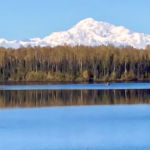Clearing Customs Along the Alaska Highway
Tom George, AOPA Alaska Regional Manager
For northbound aircraft entering Alaska from Canada, Northway has been a popular location to clear U.S. Customs before proceeding on to other destinations in the state.
Inspection services by U.S. Customs and Border Protection (CBP) for Northway Airport (PAOR) are managed out of the Alcan Highway station, located about 50 road miles away from the airport. Pilots planning to clear customs in Northway need to call the Alcan station well in advance to arrange for arrival.
According to CBP’s website, Customs hours at Northway Airport are currently 10 a.m. to 2 p.m., seven days a week; however, you may call the Alcan port any time, as it is open 24 hours a day. If the weather forecast looks promising, file a flight manifest through the Electronic Advance Passenger Information System (eAPIS) and call to secure permission to land the evening before you plan to depart. Be prepared to be flexible: to manage staffing, CBP may need to group several aircraft arrivals at similar times to justify sending an officer to the Northway Airport.
In some cases, CBP may offer pilots the option to make a technical stop for fuel at Tok Junction Airport (PFTO) and proceed to either Fairbanks or Anchorage to clear customs. This may be attractive, as currently there is no fuel available at Northway Airport. However, please note that pilots cannot assume CBP will provide this option. Customs is available in Anchorage, at either Ted Stevens Anchorage International Airport (PANC) or Lake Hood Airport (LHD) 24 hours a day; however, operating hours at Fairbanks International Airport (PAFA) are nominally 8 a.m. to 4 p.m. daily. Pay close attention to any other instructions the CBP official may provide. Nav Canada has been authorized to accept flight plans with a fuel stop in Tok, if preapproved by CBP.
Factors to consider in selecting a port of entry:
- My personal strategy when crossing international borders is to clear customs as soon as possible after entering the new country, even if fuel isn’t available at the airport of entry. From a risk management perspective, it removes the pressure to continue in the face of changing weather conditions to meet the ETA that CBP is expecting me to keep. Having a careful look at the weather prior to accepting a plan to clear customs at a more distant location such as Fairbanks or Anchorage would be prudent.
- If you are forced to land short of your planned port of entry due to weather or mechanical problems, call CBP immediately and advise them of your situation. Officials understand there are occasional “challenges” with general aviation operations but need to be kept informed. Don’t forget or put it off.
- If you have the range and the weather to comfortably make Fairbanks or Anchorage without a fuel stop, go ahead and file an eAPIS for that destination and remember to call CBP prior to departing Canada. The old practice of adding a customs advisory notice “ADCUS” to the remarks section of a flight plan is no longer allowed.
Crossing international borders has certainly become more complicated since September 11, 2001. While the eAPIS system is a bit of a pain to set up in the first place, it essentially provides in advance the information you used to be asked to supply after arrival at a port of entry. In my experience, it has cut down on my time clearing Customs after arriving at the port of entry.
If you have problems with Customs when flying into Alaska, please let AOPA know and contact the CBP Port Director. Send me an email if you encounter a problem that we should know about. But don’t let these procedures keep you from flying between Alaska and Canada.
This article was originally published on AOPA’s website at: Clearing Customs along the Alaska Highway – AOPA (https://www.aopa.org/news-and-media/all-news/2025/june/04/clearing-customs-along-the-alaska-highway)
Tom George serves as the Aircraft Owners and Pilots Association’s Regional Manager for Alaska. He resides in Fairbanks and owns a Cessna 185. He may be reached at tom.george@aopa.org or 301-695-2092.

